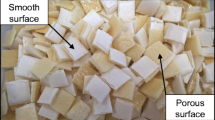Abstract
Eutrophication of reservoirs, lakes and rivers is the phenomenon that induces algal blooms by accumulating nutriments in the water system because of the continuous inflow of pollutants such as domestic sewage and industrial wastewater. This phenomenon is a global environmental problem that threatens water systems, coastal ecosystems and even human life. A recent method to solve the problem is the use of scaffolding for releasing algicide. Although this method has the effect of controlling algae, it can cause secondary environmental problems such as toxicity to other species and waste of the used scaffold. In this research, to improve the eco-friendliness and efficiency of the algicide-releasing process, biodegradable polymer foam as a carrier of the algicide was prepared. Polylactide is a biodegradable polymer that can be obtained from natural resources such as cornstarch and tapioca starch. Polylactide foam, which has high porosity and surface area because of its open-cell structure, was produced using the salt-leaching method. The most important property of polylactide foam is controlling the pore size to make it suitable for the size of the algicide. The pore size of polylactide foam is controlled by the size of the used salt particle itself. The pore size and porosity were confirmed by analyzing the morphology of polylactide foam. The algicide was loaded on the polylactide foam using the injection method. A microcosm test of Stephanodiscus was performed to confirm the efficiency of algicide release from the polylactide foam. To investigate the biodegradability of the polylactide foam, an enzymatic degradation test was performed.
Similar content being viewed by others
References
Y. H. Kang, S. W. Jung, J. H. Joo, and M. S. Han, Hydrobiologia, 683, 151 (2012).
A. M. Koss and W. E. Snyder, Biol. Control, 32, 243 (2005).
V. I. Kolmakov, N. A. Gaevskii, E. A. Ivanova, O. P. Dubovskaya, I. V. Gribovskaya, and E. S. Kravchuk, Russ J. Ecol., 33, 108 (2002).
OECD, OECD Environmental Outlook to 2050, p.218, OECD Publishing, 2012.
J. Barica, H. Kling, and J. Gibson, Can. J. Fish. Aquat. Sci., 37, 1175 (1980).
S. W. Jung, Y. H. Kang, T. Katano, B. H. Kim, S. Y. Cho, J. H. Lee, Y. O. Kim, and M. S. Han, J. Appl. Phycol., 22, 409 (2010).
C. Lovejoy, J. P. Bowman, and G. M. Hallegraeff, Appl. Environ. Microb., 64, 2806 (1998).
M. Furuki and M. Kobayashi, Mar. Pollut. Bull., 23, 189 (1991).
J. E. Newell, R. J. Mazaika, and W. J. Cook, J. Agr. Food Chem., 6, 669 (1958).
M. W. Foote, J. E. Little, and T. J. Sproston, J. Biol. Chem., 181, 481 (1949).
S. H. Park and S. H. Kim, Fashion and Textiles, 1, 1 (2014).
S. H. Lee, T. H. Han, and S. H. Kim, Macromol. Res., 22, 782 (2014).
K. K. Choi, S. H. Park, K. W. Oh, and S. H. Kim, Macromol. Res., 23, 333 (2015).
M. Mihai, M. A. Huneault, B. D. Favis, and H. Li, Macromol. Biosci., 7, 907 (2007).
J. H. Lee, S. H. Park, and S. H. Kim, Macromol. Res., 21, 1218 (2013).
J. H. Lee, S. H. Park, and S. H. Kim, Macromol. Res., 22, 424 (2014).
J. H. Bae and S. H. Kim, Polym. Int., 64, 821 (2015).
V. Maquet, S. Blacher, R. Pirard, J. P. Pirard, and R. Jerome, Langmuir, 16, 10463 (2000).
L. M. Mathieu, T. L. Mueller, P. E. Bourban, D. P. Pioletti, R. Muller, and J. A. E. Manson, Biomaterials, 27, 905 (2006).
A. G. Mikos, A. J. Thorsen, L. A. Czerwonka, W. Bao, and R. Langer, Polymer, 35, 1068 (1994).
S. T. Lee, L. Kareko, and J. Jun, J. Cell Plast., 44, 293 (2008).
G. Rizvi, L. M. Matuana, and C. B. Park, Polym. Eng. Sci., 40, 2124 (2000).
J. T. Kang, S. H. Park, and S. H. Kim, J. Compos. Mater., 48, 2567 (2014).
S. Li, A. Girard, H. Garreau, and M. Vert, Polym. Degrad. Stabil., 71, 61 (2001).
H. Cai, V. Dave, R. A. Gross, and S. P. McCarthy, J. Polym. Sci. Pol. Phys., 34, 2701 (1996).
D. K. Owens and R. C. Wendt, J. Appl. Polym. Sci., 13, 1741 (1969).
I. Sava and S. Chisca, Mater. Chem. Phys., 134, 116 (2012).
A. J. Kinloch, “Adhesion and Adhesives: Science and Technology”, pp.18–51, Chapman and Hall, New York, 1987.
Author information
Authors and Affiliations
Corresponding authors
Rights and permissions
About this article
Cite this article
Bae, J.H., Joo, JH., Lee, Y.J. et al. Fabrication of biodegradable polylactide foam for algal bloom control. Fibers Polym 16, 2087–2093 (2015). https://doi.org/10.1007/s12221-015-5555-8
Received:
Revised:
Accepted:
Published:
Issue Date:
DOI: https://doi.org/10.1007/s12221-015-5555-8




